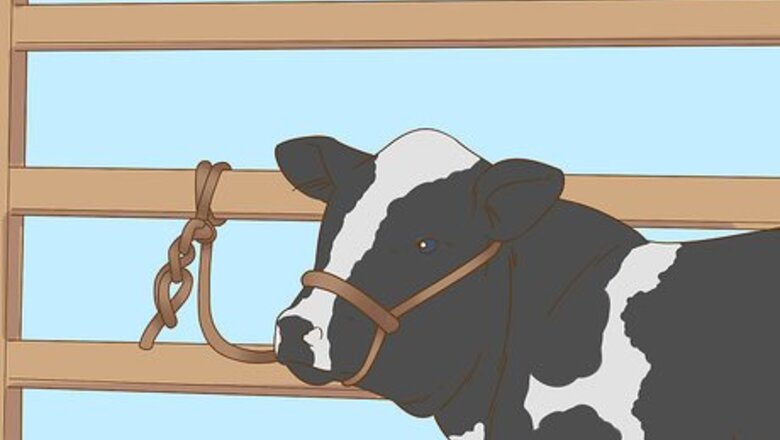
views
Securing the Cow and Cleaning the Udder
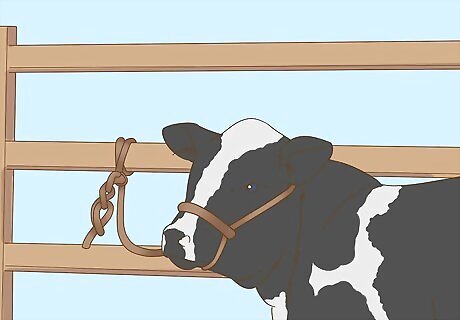
Tie the cow to a stable fixture. Make sure the cow is wearing a halter, and tie the lead end to a sturdy post or another immovable beam. Tie the cow in a low-stress, quiet environment. If cows are anxious or afraid, the milking process will be more difficult and unpleasant for both you and the animal. If you are working on a farm that has a stanchion (a wooden box-like structure used for securing a cow’s head so that it can be milked, vaccinated, or branded), you can effectively secure the cow. Sophisticated stanchions will have a bar or lever on the side that will gently clamp wooden or metal slats around the cow’s neck and hold it immobile. More rudimentary stanchions may need to be fastened with a crossbeam or piece of wire.
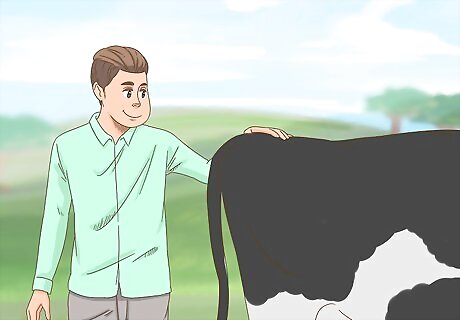
Approach the cow slowly. When moving near to clean the udder, speak in a low voice and gently pat her side so that she knows where you are. Cows have a 300-degree range of vision, meaning they can see all around them without moving their heads, minus what is directly in front and behind of them. Despite this great range of vision, their depth perception is pretty poor, which is why it is important to talk to the cow as you approach her from the side to let her know where you are and that you are getting closer. Don’t make any sudden movements. If you surprise her, she may panic and kick you or step on you. Tying the cow’s tail to her leg will prevent her from swishing you with it. Tail hair does not tie well, and it will come loose after a few minutes. Alternatively, you can tie the tail up and around the neck, which may be less frightening to the cow.
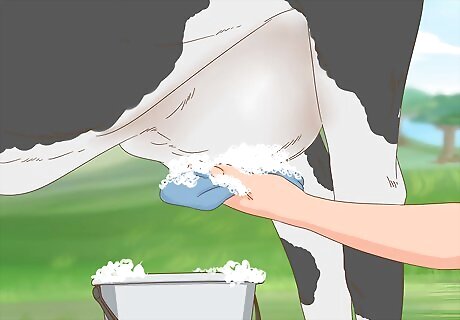
Clean the teats with soapy water or iodine. During the course of a day, the cow’s teats will become covered in grass, hay, and dirt. Wash the teats before you begin milking to prevent soil—and any bacteria that it may contain—from contaminating the milk. When washing, try not to drag any dirt down to your clean area. Be mindful of the direction and borders of your washed area. Washing with warm water may help coax or “bring down” the milk.
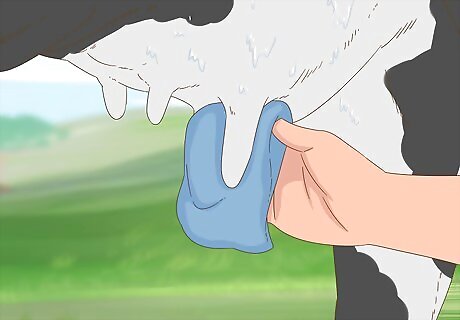
Dry the teats before milking. Do not milk the cow if her teats are still wet, because the soap and water may drip down into the milk bucket and contaminate the milk. Dry the teats using a clean, soft cotton cloth. As you dry them, don’t scratch or irritate the teats. They are sensitive, and the cow may jerk or try to kick you if you cause any pain.
Milking a Cow by Hand
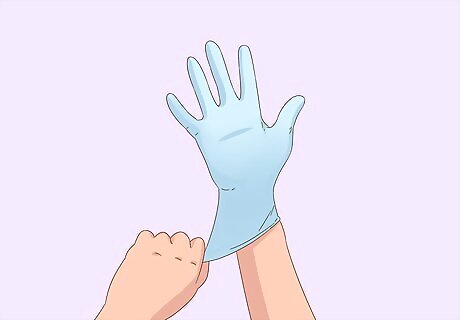
Protect or lubricate your hands. Your hands can carry bacteria, which may be harmful if transmitted to the cow. To keep both you and the cow healthy, and to avoid scratching the cow’s udder with rough hands, put on a pair of latex gloves before you start milking. If you prefer not to use gloves, apply a lubricant such as petroleum jelly to your hands to minimize friction. Some people prefer to use udder cream (also called udder balm or udder butter) to lubricate the cow’s udder. Like petroleum jelly, udder cream will reduce friction during milking. You can purchase udder cream at any farm or ranch supply store.
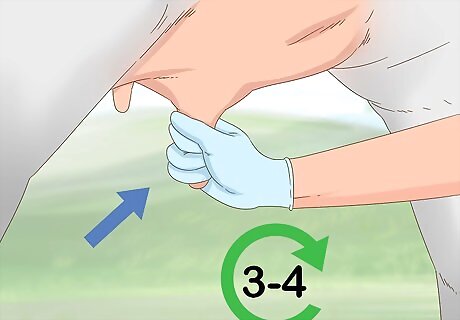
Strip each teat 3 or 4 times. “Stripping” is the process of pulling down a cow’s teat (using a normal milking grip) in order to pass any dirt, bacteria, or other debris from the milk ducts. Do not catch the milk from stripping in the milk bucket, as it is generally not clean and should not be consumed.
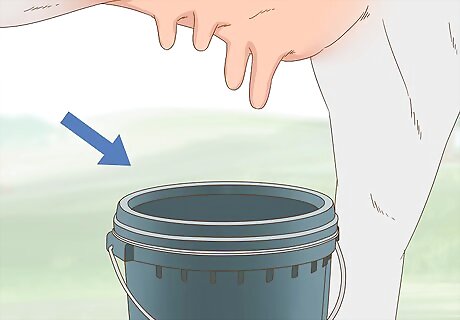
Place a bucket underneath the udder. This will catch the milk that you squeeze from the udder. Better yet, hold the bucket between your legs. It takes practice, but this can be done easily and comfortably. This position reduces the chance of the cow kicking over the pail of milk. Some cows only stand still if they’re given grain or hay to munch on while you go about your business. If your cow is demanding, keep an eye on her food. Be ready to replenish it, or else she’ll let you know she wants more by becoming restless and difficult to work with.
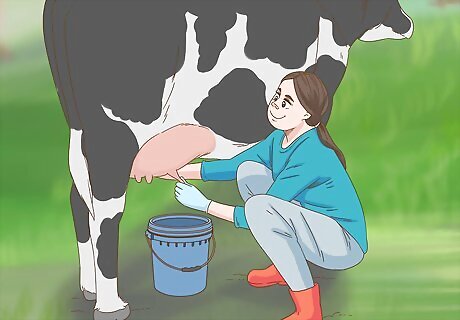
Sit or squat on the cow’s right side. Seat yourself in a position that will allow you to move away quickly if the cow becomes uncooperative. If you sit on a stool to milk the cow, position it very close to the cow. Your body should be very close to the cow—practically underneath it—so that there is as little distance as possible between the bucket and udder. Sitting as close as possible to the cow protects you because if she does kick out you will merely be knocked over, versus giving her a distance to connect with and hurt you. Sitting cross-legged on the ground is not safe, as the cow could easily step on or kick you.
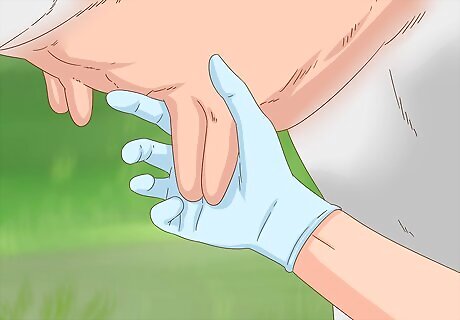
Wrap a hand around 2 of the 4 teats. Choose diagonal teats (front left and rear right, for example). Or, try the front teats first, then the back pair. Begin milking by gently clamping (almost pinching) each teat between your extended thumb and first finger, so that the teat fills your palm as you squeeze down. You may need to “bump the bag” or gently bump against/nudge the udder to help stimulate the udder to let down milk as a calf would. This can help the cow's milk let down and increase your yield.
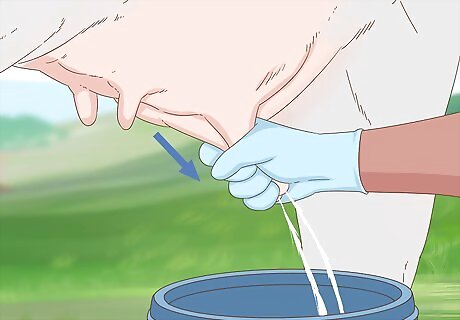
Squeeze down to push out the milk. As you press down on the teat, maintain your grip on the base of the teat so that the milk doesn’t flow back up into the udder. Do not jerk or yank the teats. This motion is performed by sequentially squeezing your fingers from the middle to the pinky to force the milk out. Be gentle yet firm.
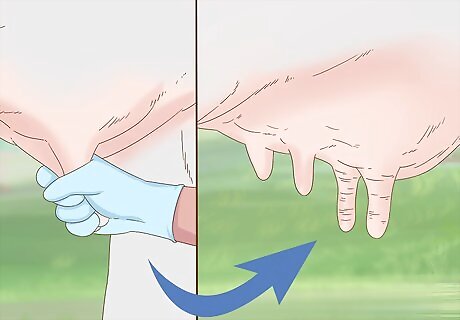
Milk until the quarter that you’re milking looks deflated. Often even looking at the quarter just milked can tell you if it’s been emptied enough or not. Whereas a full udder will appear tight and be firm to the touch, an emptied quarter of the udder will look saggy and wrinkled and feel much softer and more malleable. Experienced farmers can feel the udder to know exactly when all the milk has come down. After you’ve milked 1 quarter, repeat the motion with your other hand on the adjacent quarter. Most people prefer to alternate (right hand, left hand, right hand, etc.) The downward squeezing motion takes less effort doing it in alternate steps than all at the same time.
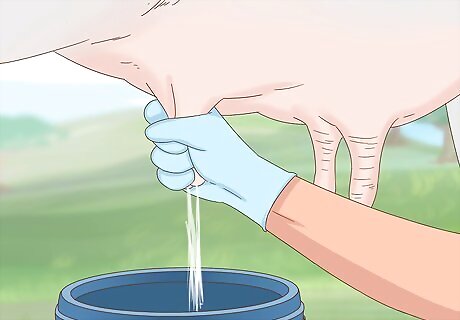
Move on to milk the other 2 teats. If you began by milking the 2 teats on the right-hand side of the cow, you’ll need to pick up your stool and move to the cow’s left side to access the left two teats. If you used the diagonal method, switching sides is not necessary. Watch your feet when moving near the cow. A cow often weighs over 1,000 lbs (450 kg). If she steps on your foot, those 1,000 lbs will hurt quite a bit and could break your foot.
Milking with a Machine
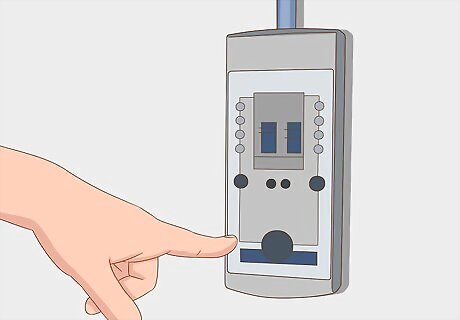
Turn on the milking machine. The machine will need to be running for a few minutes before you begin milking the cow, in order to build pressure. Use this time to secure your cow and wash and dry her udder.
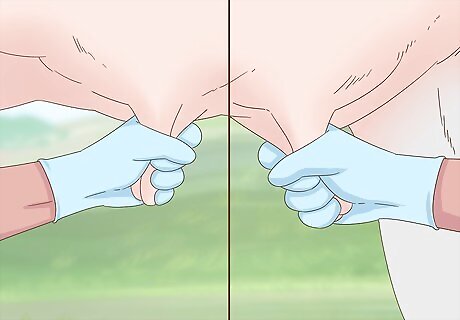
Hand-milk each teat a few times to let down the milk. This process is known as “stripping,” and, in addition to encouraging milk to flow from the cow’s teats, will squirt out any dirt or bacteria that has built up in the cow’s teat. Consequently, the milk produced from stripping should not be squirted into the bucket, or it may contaminate the rest of the milk. Let it fall onto the ground.
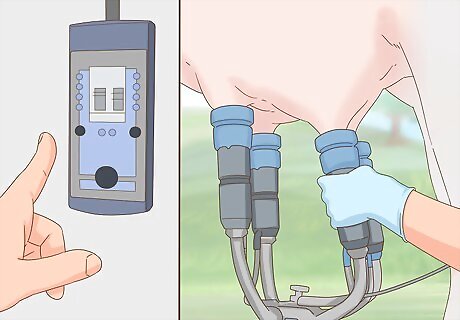
Release the machine’s pressure and place each suction device on each teat. As soon as you release the pressure buildup on the milking machine, suction begins. As quickly as possible, place each suction cup over one of the cow’s four teats. As the milk begins to flow from the teats into the suction device, adjust the devices so that they hang straight down from the udder. Some cows lift their back leg and kick over the bucket or knock off the suction devices. Keep the handle positioned so you can grab the bucket should she decide to kick the bucket. For this reason as well you should do your best to monitor and not walk away from the cows when they are being milked.
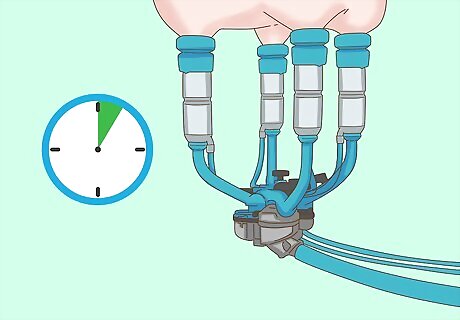
Leave the milking device on for 5–7 minutes. Wait until the machine draws all of the milk out of the udder, which will become flaccid. All cows are a little different, but most will be fully milked out within 5 minutes. Due to udder differences or teat structural problems, some cows will take more than 7 minutes to be fully milked. Keep an eye on the milking device, and make sure that milk is still flowing. As soon as milk stops flowing, remove the device.
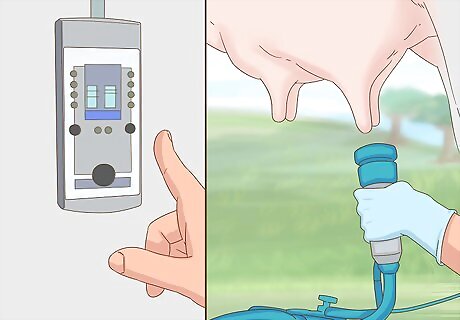
Turn off the device’s suction. Then remove the suction devices from the teats. The order is important: if you try to remove the milking device while suction is still on, you risk causing pain to the cow and damaging the sensitive tissue around her teats. Many modern milking machines do not require the person milking the cow to manually remove the suction cups. Once one quarter has been milked dry, they automatically fall off, one by one. Be careful not to trip over the milking machine’s tubes or wires as you move around the milking area.
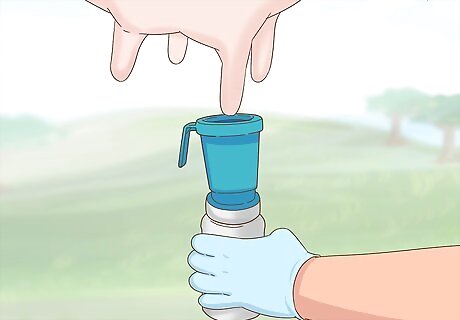
Clean the cow’s udder. Cows’ teats are vulnerable to bacteria and infection immediately after having been milked and should be cleaned and protected. The most efficient method of protecting a cow’s teats is to apply a post-milking disinfectant. This dark, thick liquid coats each of the cow’s four teats and prevents bacteria from entering. Cows often like to eat after they’ve been milked, so provide the cow with fresh grass or hay.















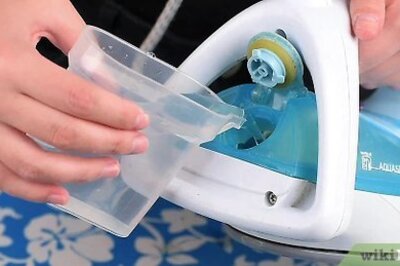



Comments
0 comment